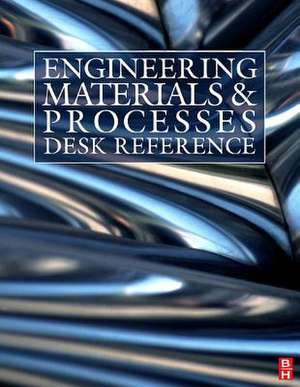Engineering Materials and Processes Desk Reference
Autor Michael F. Ashby, Robert W. Messler, Rajiv Asthanaen Limba Engleză Paperback – 31 dec 2008
* A hard-working desk reference, providing all the essential material needed by engineers on a day-to-day basis
* Fundamentals, key techniques, engineering best practice and rules-of-thumb together in one quick-reference sourcebook
* Definitive content by the leading authors in the field, including Michael Ashby, Robert Messler, Rajiv Asthana and R.J. Crawford
Preț: 672.81 lei
Preț vechi: 755.97 lei
-11% Nou
128.76€ • 133.93$ • 106.30£
Carte indisponibilă temporar
Specificații
Notă biografică
Royal Society Research Professor Emeritus at Cambridge University and Former Visiting Professor of Design at the Royal College of Art, London, UK Mike Ashby is sole or lead author of several of Elsevier's top selling engineering textbooks, including Materials and Design: The Art and Science of Material Selection in Product Design, Materials Selection in Mechanical Design, Materials and the Environment, and Materials: Engineering, Science, Processing and Design. He is also coauthor of the books Engineering Materials 1&2, and Nanomaterials, Nanotechnologies and Design. Rajiv Asthana, Ph.D., FASM, is Fulton and Edna Holtby Endowed Chair in manufacturing at the University of Wisconsin-Stout where he teaches in the manufacturing engineering program. He is Editor of Journal of Materials Engineering & Performance and on the editorial boards of Ceramics International and Materials Science and Engineering A. He has authored or coauthored five books, including Materials Science in Manufacturing (Elsevier) and 160 scientific publications, and co-edited Ceramic Integration and Joining Technologies (Wiley). His research interests include ceramic/metal joining, high-temperature capillarity and cast metal-matrix composites. Dr. Edward Furlani holds BS degrees in both physics and electrical engineering, and MS and PhD degrees in theoretical physics from the State University of New York at Buffalo. He is currently a research associate in the research laboratories of the Eastman Kodak Company, which he joined in 1982. He has worked in the area of applied magnetics for over 15 years. His research in this area has involved the design and development of numerous magnetic devices and processes. He has extensive experience in the analysis and simulation of a broad range of magnetic applications including rare-earth permanent magnet structures, magnetic drives and suspensions, magnetic circuits, magnetic brush subsystems in the electrophotographic process, magnetic and magneto-optic recording, high-gradient magnetic separation, and electromechanical devices such as transducers, actuators and motors. His current research activity is in the area of microsystems and involves the analysis and simulation of various micro-electromechanical systems (MEMS) including light modulators, microactuators and microfluidic components. Dr. Furlani has authored over 40 publications in scientific journals and holds over 100 US patents. After gaining his PhD in 1953, Professor Smallman spent five years at the Atomic Energy Research Establishment at Harwell before returning to the University of Birmingham, where he became Professor of Physical Metallurgy in 1964 and Feeney Professor and Head of the Department of Physical Metallurgy and Science of Materials in 1969. He subsequently became Head of the amalgamated Department of Metallurgy and Materials (1981), Dean of the Faculty of Science and Engineering, and the first Dean of the newly created Engineering Faculty in 1985. For five years he wasVice-Principal of the University (1987-92). He has held visiting professorship appointments at the University of Stanford, Berkeley, Pennsylvania (USA), New SouthWales (Australia), Hong Kong and Cape Town, and has received Honorary Doctorates from the University of Novi Sad (Yugoslavia), University ofWales and Cranfield University. His research work has been recognized by the award of the Sir George Beilby Gold Medal of the Royal Institute of Chemistry and Institute of Metals (1969), the Rosenhain Medal of the Institute of Metals for contributions to Physical Metallurgy (1972), the Platinum Medal, the premier medal of the Institute of Materials (1989), and the Acta Materialia Gold Medal (2004). Hewas elected a Fellowof the Royal Society (1986), a Fellowof the RoyalAcademy of Engineering (1990), a Foreign Associate of the United States National Academy of Engineering (2005), and appointed a Commander of the British Empire (CBE) in 1992. A former Council Member of the Science and Engineering Research Council, he has been Vice-President of the Institute of Materials and President of the Federated European Materials Societies. Since retirement he has been academic consultant for a number of institutions both in the UK and overseas. Professor Ngan obtained his PhD on electron microscopy of intermetallics in 1992 at the University of Birmingham, under the supervision of Professor Ray Smallman and Professor Ian Jones. He then carried out postdoctoral research at Oxford University on materials simulations under the supervision of Professor David Pettifor. In 1993, he returned to the University of Hong Kong as a Lecturer in Materials Science and Solid Mechanics, at the Department of Mechanical Engineering. In 2003, he became Senior Lecturer and in 2006 Professor. His research interests include dislocation theory, electron microscopy of materials and, more recently, nanomechanics. He has published over 120 refereed papers, mostly in international journals. He received a number of awards, including the Williamson Prize (for being the top Engineering student in his undergraduate studies at the University of Hong Kong), Thomas Turner Research Prize (for the quality of his PhD thesis at the University of Birmingham), Outstanding Young Researcher Award at the University of Hong Kong, and in 2007 was awarded the Rosenhain Medal of the Institute of Materials, Minerals and Mining. He also held visiting professorship appointments at Nanjing University and the Central Iron and Steel Research Institute in Beijing, and in 2003, he was also awarded the Universitas 21 Fellowship to visit the University of Auckland. He is active in conference organization and journal editorial work. Russell J. Crawford is Professor and Dean of the Faculty of Life and Social Sciences at Swinburne University of Technology, Melbourne, Australia.
